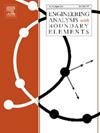Fluid topology optimization using quadtree-based scaled boundary finite element method
IF 4.2
2区 工程技术
Q1 ENGINEERING, MULTIDISCIPLINARY
Engineering Analysis with Boundary Elements
Pub Date : 2024-11-15
DOI:10.1016/j.enganabound.2024.106019
引用次数: 0
Abstract
This paper presents a fluid topology optimization method utilizing a quadtree scaled boundary finite element method (SBFEM). The method aims to minimize energy dissipation during fluid flow by employing quadtree mesh refinement in the design domain, integrating both velocity and pressure fields. Finer meshes are used near the fluid-structure interface and coarser meshes elsewhere. By leveraging the Stokes control equations for incompressible viscous fluids, the scaled boundary finite element transformation addresses hanging node issues between different elements and simplifies numerical computations by eliminating the need to solve fundamental solutions within the domain. The density-based topology optimization method is then used to determine optimal channel layouts. This proposed method reduces the number of elements and degrees of freedom (DOFs) of design variables while enhancing numerical analysis accuracy. By testing a series of numerical examples, the proposed method can obtain consistent results as those of finite-element-method (FEM)-based topology optimization with shortened time, which demonstrates the accuracy and efficiency of the proposed method.
利用基于四叉树的缩放边界有限元法优化流体拓扑结构
本文介绍了一种利用四叉树缩放边界有限元法(SBFEM)进行流体拓扑优化的方法。该方法旨在通过在设计域中采用四叉树网格细化,整合速度场和压力场,最大限度地减少流体流动过程中的能量耗散。在流体-结构界面附近使用较细的网格,其他地方则使用较粗的网格。通过利用不可压缩粘性流体的斯托克斯控制方程,缩放边界有限元变换解决了不同元素之间的悬挂节点问题,并通过消除在域内求解基本解的需要简化了数值计算。然后使用基于密度的拓扑优化方法来确定最佳通道布局。这种拟议的方法减少了元素数量和设计变量的自由度 (DOF),同时提高了数值分析的准确性。通过对一系列数值实例的测试,所提出的方法可以在更短的时间内获得与基于有限元法(FEM)的拓扑优化方法一致的结果,这证明了所提出方法的准确性和高效性。
本文章由计算机程序翻译,如有差异,请以英文原文为准。
求助全文
约1分钟内获得全文
求助全文
来源期刊

Engineering Analysis with Boundary Elements
工程技术-工程:综合
CiteScore
5.50
自引率
18.20%
发文量
368
审稿时长
56 days
期刊介绍:
This journal is specifically dedicated to the dissemination of the latest developments of new engineering analysis techniques using boundary elements and other mesh reduction methods.
Boundary element (BEM) and mesh reduction methods (MRM) are very active areas of research with the techniques being applied to solve increasingly complex problems. The journal stresses the importance of these applications as well as their computational aspects, reliability and robustness.
The main criteria for publication will be the originality of the work being reported, its potential usefulness and applications of the methods to new fields.
In addition to regular issues, the journal publishes a series of special issues dealing with specific areas of current research.
The journal has, for many years, provided a channel of communication between academics and industrial researchers working in mesh reduction methods
Fields Covered:
• Boundary Element Methods (BEM)
• Mesh Reduction Methods (MRM)
• Meshless Methods
• Integral Equations
• Applications of BEM/MRM in Engineering
• Numerical Methods related to BEM/MRM
• Computational Techniques
• Combination of Different Methods
• Advanced Formulations.
 求助内容:
求助内容: 应助结果提醒方式:
应助结果提醒方式:


